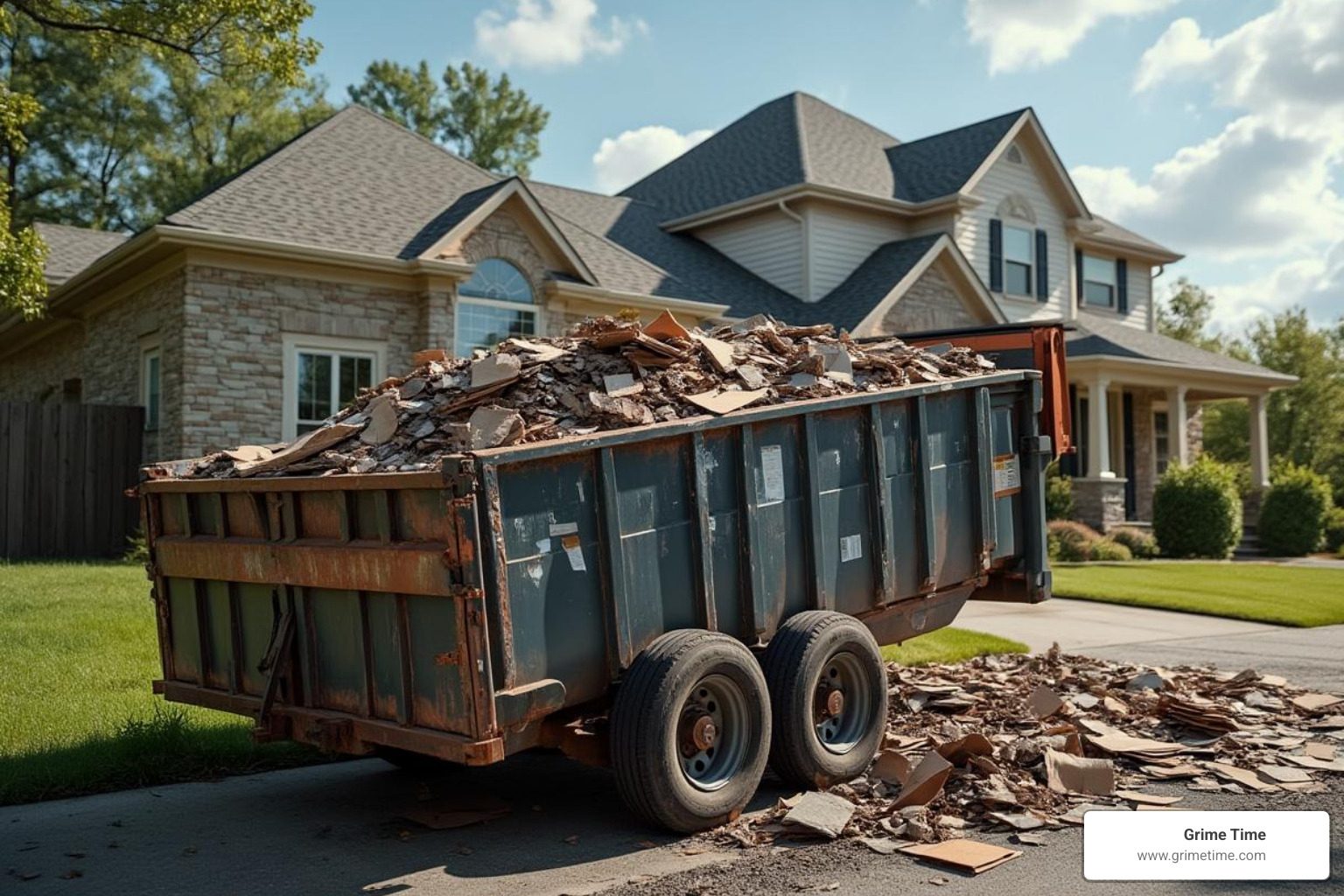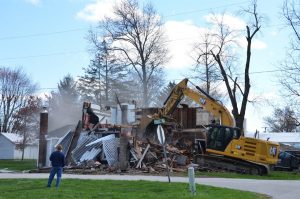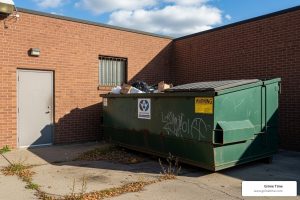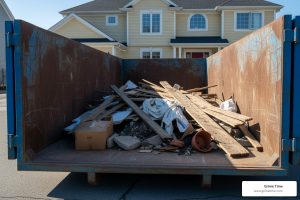Why Your Roofing Project Needs a Dedicated Dumpster
For most residential roofing projects, a 20-yard roll-off dumpster is typically ideal. This size usually handles 2,500-3,000 square feet of single-layer standard shingles, with an average weight limit of 4,000-6,000 pounds.
A dumpster rental for roofing is not just about tossing old shingles. It’s about keeping your job site safe, efficient, and clean. Roofing projects create a lot of debris. Think about all those old shingles, nails, and underlayment. Without a dedicated place for this waste, your worksite can quickly become a mess. This slows down your crew and creates safety hazards.
As a busy contractor, you need solutions that work. You don’t have time for delays or hidden fees. A reliable dumpster service helps you stay on schedule and on budget. It makes debris removal easy, so your team can focus on the roof, not the trash.
Choosing the right dumpster size is key. It ensures you have enough space for all your waste without paying for too much. It also helps avoid costly overage fees if you go over weight limits.
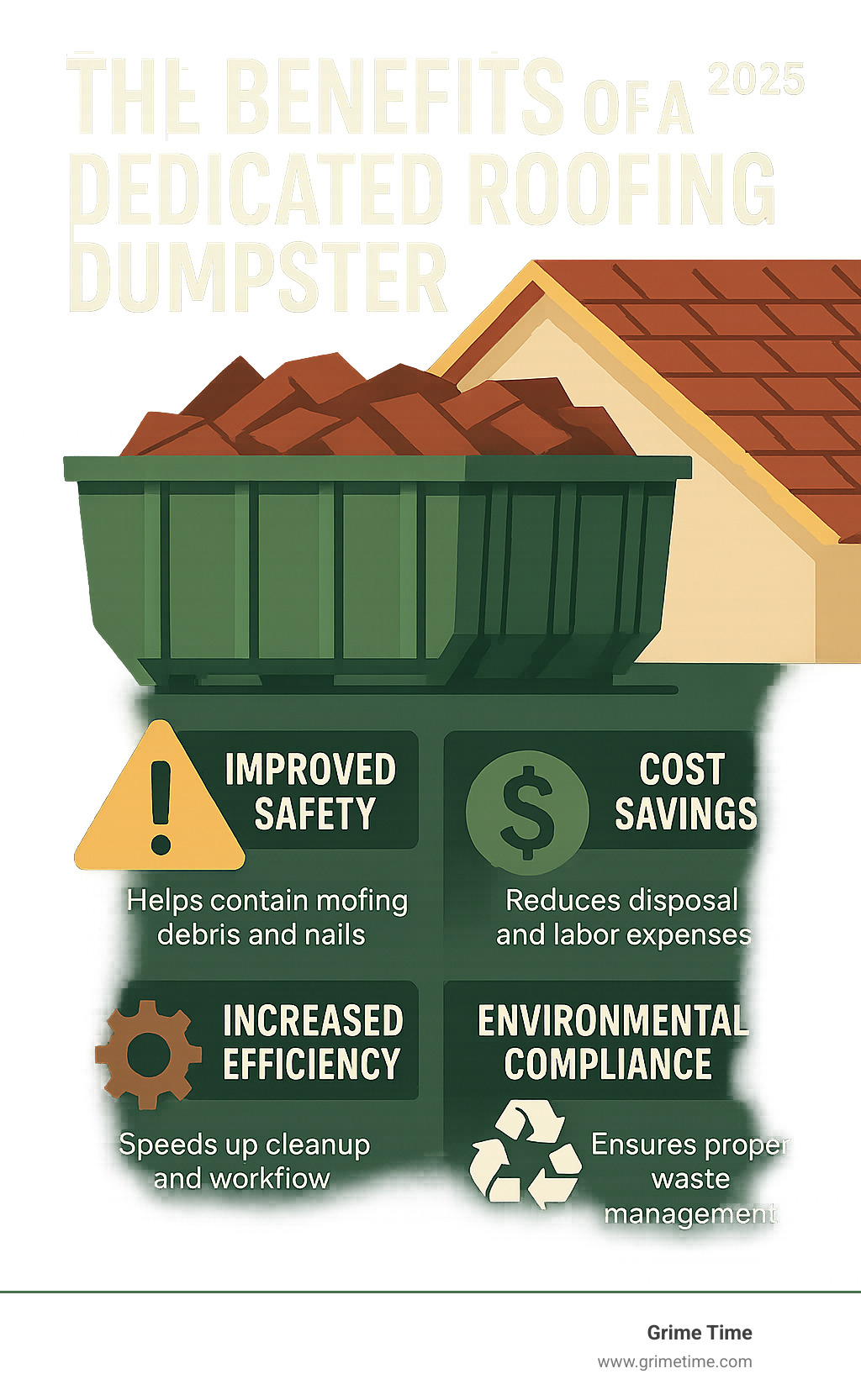
Dumpster rental for roofing word guide:
Decoding Roofing Debris: What Can You Toss and How Much Does It Weigh?
For any dumpster rental for roofing, understanding debris type and weight is half the battle. Roofing projects generate a surprising amount of heavy waste, from old shingles and underlayment to nails and bits of lumber.
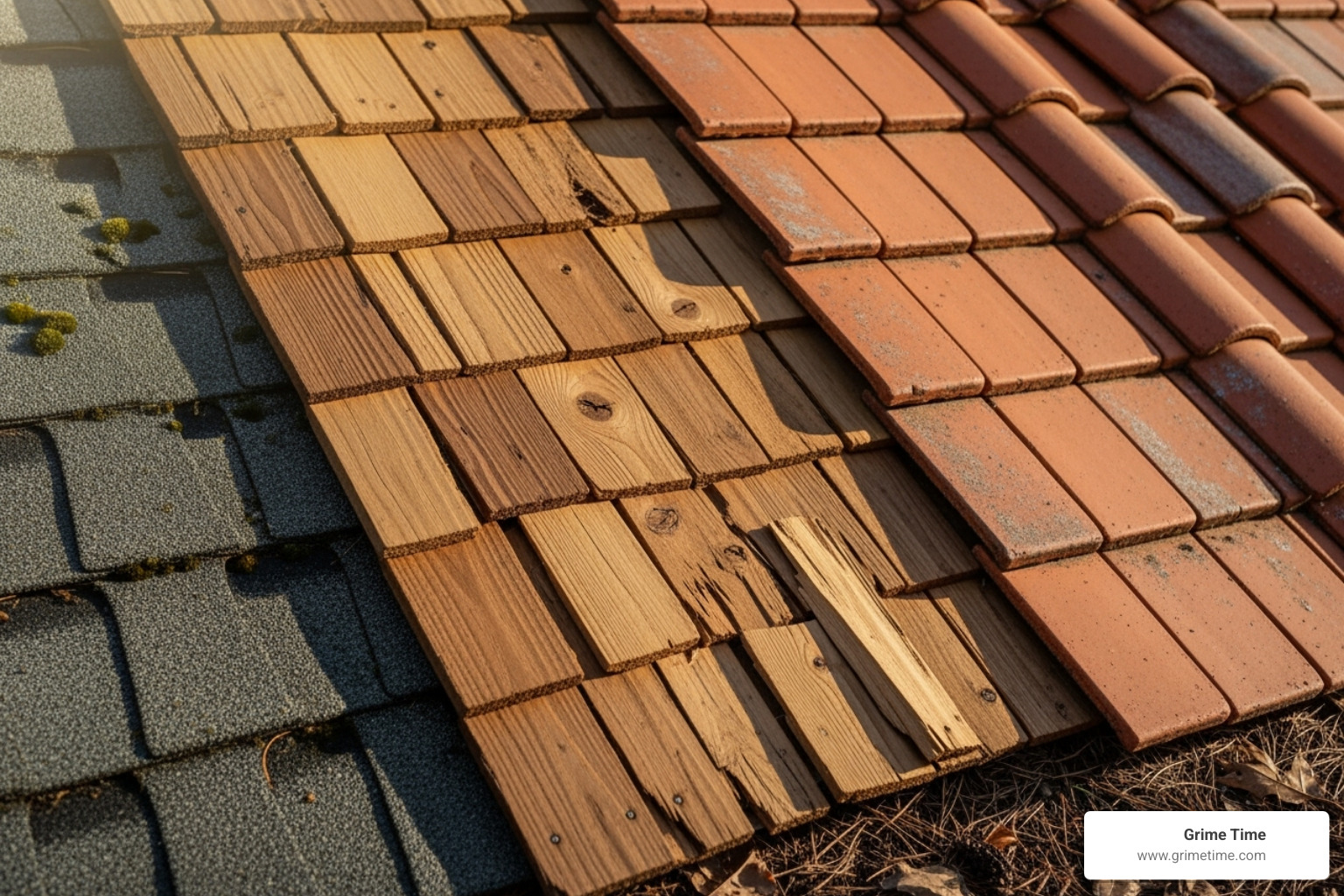
The density of roofing materials means weight, not volume, is the key factor for your dumpster needs. Underestimating debris weight can lead to frustrating overage charges or needing a second dumpster. At Grime Time, we help you avoid these issues and ensure your project runs smoothly.
Accepted Roofing Materials for Your Dumpster
Let’s clarify what materials you can typically dispose of in a dumpster rental for roofing. Our dumpsters are designed to handle the common debris found on a roofing job site, making your cleanup process straightforward.
Here’s a list of generally accepted roofing materials:
- Asphalt Shingles: This is the most common type of roofing debris. This includes:
- 3-tab shingles: The traditional, lighter option.
- Architectural shingles (or laminate shingles): Heavier and more durable.
- Premium shingles: The heaviest of the asphalt family.
- Wood Shakes and Shingles: If you’re replacing a wood roof, these are perfectly fine.
- Underlayment and Felt Paper: The protective layers beneath the shingles.
- Flashing and Trim: Metal or composite pieces used around chimneys, vents, and edges.
- Nails and Fasteners: All the small bits that held the old roof down.
- Lumber: Small pieces of wood from the roof deck or framing that may be removed during the tear-off.
Certain materials are prohibited in standard dumpsters for safety, environmental, or legal reasons. This includes hazardous waste like asbestos, chemicals, paints, oils, and tires. If you have questions about specific items, just ask us. We’re here to ensure a compliant, hassle-free disposal. For a comprehensive list, see our guide on What Can and Cannot Go in a Dumpster.
The Critical Role of Weight in Roofing Debris
Now, let’s talk weight. For roofing debris, weight is more important than volume. Shingles are incredibly dense; you could fill a large dumpster halfway and already be over its weight limit. Understanding debris density is critical for avoiding tonnage overages and extra fees.
Here’s a quick look at the estimated weight of different roofing materials per 100 square feet (one roofing square), keeping in mind these are averages and can vary:
| Roofing Material Type | Estimated Weight per Square (100 sq ft) | Estimated Weight per Square Foot |
|---|---|---|
| Asphalt Shingles (3-tab) | 200 – 250 pounds | 2 – 2.5 pounds |
| Asphalt Shingles (Laminate/Architectural) | 240 – 400 pounds | 2.4 – 4 pounds |
| Asphalt Shingles (Premium) | 300 – 450 pounds | 3 – 4.5 pounds |
| Wood Shingles/Shakes | 350 – 450 pounds | 3.5 – 4.5 pounds |
| Clay or Concrete Tile | 550 – 1,000 pounds | 5.5 – 10 pounds |
| Standing Seam Metal Roof Systems | 100 – 300 pounds | 1 – 3 pounds |
Note: These estimates typically include a small allowance for underlayment, nails, and other incidental debris.
The weight differences are significant. A metal roof is much lighter than an asphalt shingle roof, which is far lighter than concrete tile. This means a 20-yard dumpster that could handle a large metal roof might only be suitable for a small tile roof simply due to weight.
Dumpsters have strict weight limits, mandated by law for road safety. Exceeding this limit leads to hefty overage charges, often $50 to $250 per ton over. That’s a cost nobody wants!
Moisture also increases debris weight. Soaked shingles weigh significantly more, so account for this potential extra weight if you’re working in wet conditions. Accurate estimation is your best friend when it comes to a cost-effective dumpster rental for roofing.
Choosing the Perfect Container: A Guide to Roofing Dumpster Sizes
Choosing the right dumpster size is crucial. Too small, and you’ll pay for extra pickups. Too big, and you’re paying for space you don’t need. The right fit makes the process smoother, more efficient, and budget-friendly.
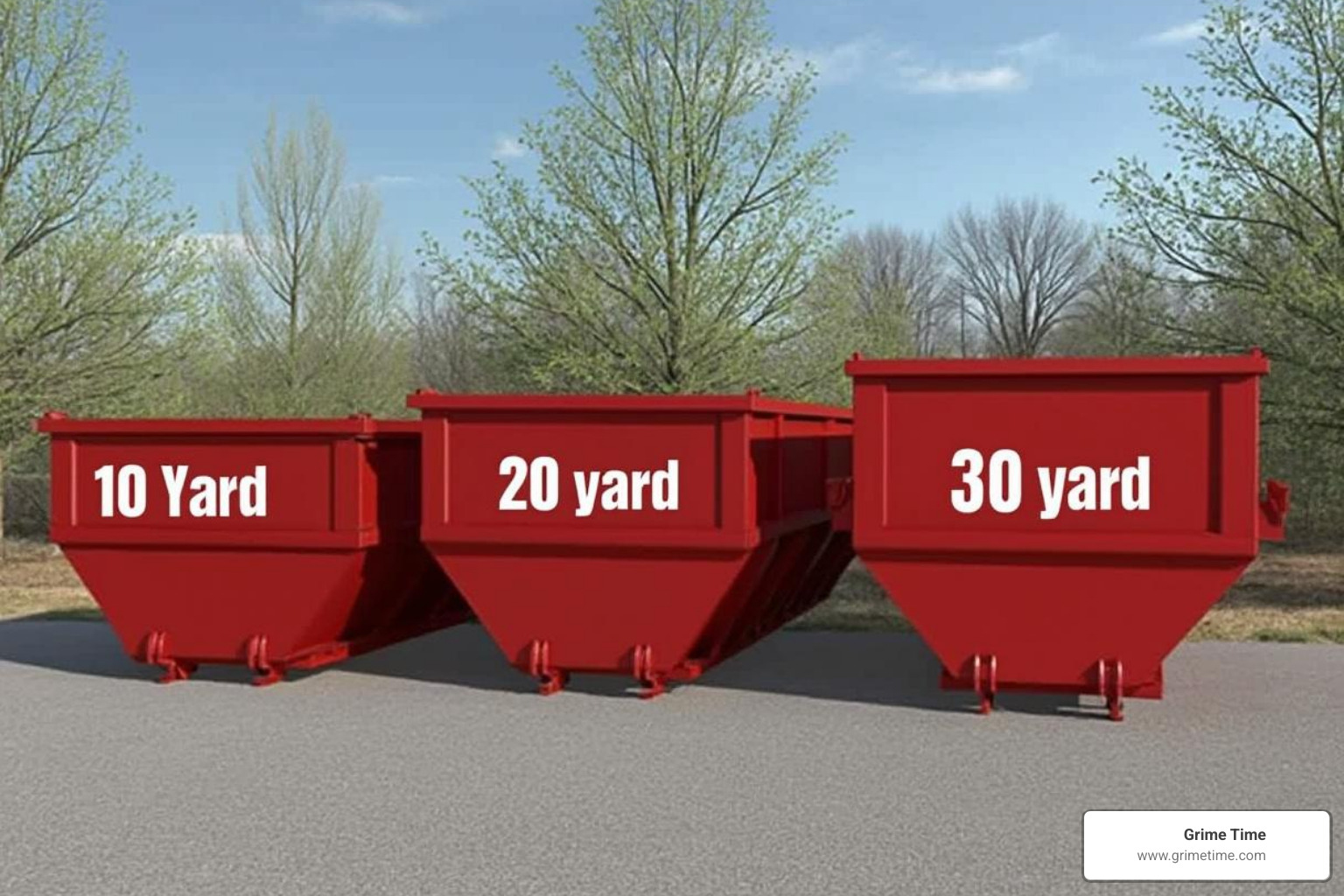
At Grime Time, we offer a range of sizes to match your project’s scale. We’ll guide you through the selection process so you can focus on the roof, not the waste.
Understanding ‘Roofing Squares’ and Calculating Your Needs
Before picking a dumpster rental for roofing, you need to understand “roofing squares.” One roofing square equals 100 square feet. A 2,000 square foot roof is 20 roofing squares.
To estimate your debris, follow these steps:
First, measure your roof’s square footage. Measure the length and width of each roof section, multiply to get the area of each, and add them together. Account for dormers and complex rooflines.
Next, convert the total to roofing squares by dividing the total square footage by 100. A 1,500 square foot roof is 15 roofing squares.
Finally, account for multiple shingle layers. This is a critical and often overlooked step. If your roof has multiple layers, multiply your debris estimate by the number of layers. A 30-square roof with two layers generates debris for 60 squares, significantly impacting the weight and the dumpster size you’ll need.

Accurately calculating roofing squares and layers gives you a clear picture of the debris volume and weight. This precise estimation is key to choosing the perfect dumpster rental for roofing.
How to Choose the Right Dumpster Rental Size for Your Roofing Project
With your roofing squares calculated, it’s time to pick a dumpster size. For roofing projects, weight is king, as shingles are deceptively heavy.
Let’s look at our common dumpster sizes and what they typically handle for roofing debris:
Our 10-yard dumpster is a fantastic choice for smaller jobs. It handles about 34 squares of 3-tab shingles or 28 squares of architectural shingles (single layer). It’s ideal for a shed or garage roof, minor repairs, or small homes with up to 15 roofing squares.
Our 20-yard dumpster is the workhorse for most residential roofing projects. It holds up to 20 cubic yards of waste, translating to about 3 tons (6,000 pounds) of roofing debris. This manages about 2,500-3,000 square feet (15-20 roofing squares) of single-layer standard shingles, making it perfect for a full tear-off on an average-sized home.
For the biggest jobs, consider our 30-yard dumpster. While it offers large volume, the weight limit is the most important factor with dense shingles. This size suits very large residential or commercial projects, or roofs with multiple layers of heavy shingles. For extremely large projects, two 20-yard bins can be more practical to stay within weight limits. Since very large dumpsters aren’t always designed for dense asphalt shingles, it’s best to confirm with us if you’re considering this size for heavy roofing debris.
When in doubt, go slightly larger to avoid costly overage fees. If you’re unsure, call us! Our experienced team in Austin and Central Texas can assess your project and recommend the most efficient and cost-effective dumpster rental for roofing solution.
For more general guidance on selecting the right size for any project, check out our detailed guide on How to Choose the Right Dumpster Rental Size.
The Ultimate Guide to Dumpster Rental for Roofing
Renting a dumpster for your roofing project shouldn’t be stressful. At Grime Time, we’ve streamlined our process to be easy and transparent. We know efficient waste management is key to keeping your project on track, clean, and safe.
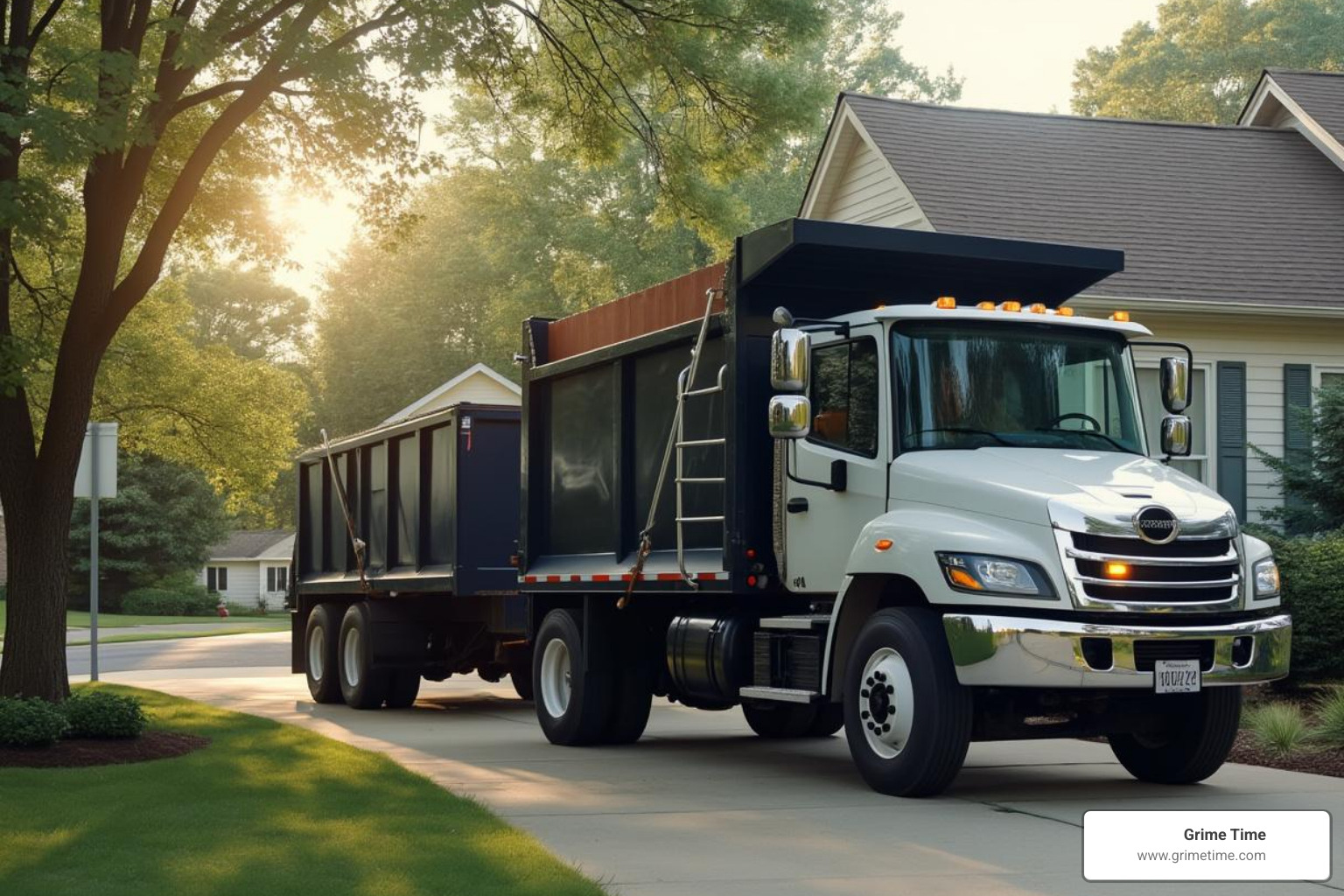
From your initial call for a dumpster rental for roofing to the final pickup, we’re with you. Our goal is a seamless experience, so you can focus on building and repairing roofs.
The Simple 4-Step Rental Process
We believe that getting a dumpster should be easy. Our process is designed for maximum convenience and minimum fuss, ensuring effective logistics management for your project.
- Site Preparation: Prepare the delivery spot before your dumpster arrives. Choose a clear, level, accessible area, like your driveway. To protect your property, place plywood sheets where the dumpster wheels will rest to prevent marks. Ensure there’s enough overhead clearance for our truck.
- Scheduling Delivery: After selecting your size and preparing the site, call us or book online. Schedule your delivery for just before demolition begins. Our team ensures prompt, dependable delivery when you need it. We serve Austin and a wide range of Central Texas communities, including Buda, Bastrop, Cedar Creek, Cedar Park, Coupland, Dale, Driftwood, Elgin, Georgetown, Hutto, Kyle, Lago Vista, Liberty Hill, Lakeway, Round Rock, San Marcos, Pflugerville, and Manor.
- Filling the Dumpster: As you tear off the old roof, toss debris directly into the dumpster. Mind the weight limit and distribute the load evenly. Do not fill the dumpster more than 80% full or above its walls to ensure safe transport.
- Arranging Pickup: When your project is done and the dumpster is full (but not overfilled), contact us to schedule pickup. We’ll arrange a convenient time to retrieve the dumpster and haul away your debris, making cleanup effortless so you can move on to your next project.
This straightforward process, combined with our reliable service, ensures that your dumpster rental for roofing is a smooth and stress-free experience from start to finish. For more details on our services, check out our Construction Roll-Off Dumpster Rental page.
Understanding Costs and Avoiding Hidden Fees
Nobody likes cost surprises. At Grime Time, we offer transparent pricing with no hidden fees for your dumpster rental for roofing. You’ll know exactly what you’re paying for upfront.
Here’s a breakdown of the factors that influence your roofing dumpster rental cost:
- Rental Period: Our standard rental includes a set number of days. If you need more time, let us know to discuss extension options.
- Weight Limits: Weight is a huge factor for roofing debris. Each dumpster has a specific weight limit in tons. Exceeding this limit is the most common reason for extra charges.
- Overage Fees: These are charges for exceeding the included weight limit, calculated per ton over. Accurate weight estimation is vital. Our transparent pricing explains the overage fee structure upfront.
- Trip Fees: A trip fee may be assessed if a dumpster is inaccessible or unsafely overfilled. We provide clear guidelines to help you avoid this.
- Type of Debris: Roofing debris is generally uniform. Mixing in prohibited items may lead to extra fees. Always confirm what’s allowed.
Our Commitment to Transparent Pricing:
Our commitment is to transparent pricing. We provide a clear, upfront quote including delivery, pickup, rental period, and a generous weight allowance. No hidden fees or surcharges. We want you to feel in control of your budget. For details, visit our Dumpster Rental Pricing page.
Special Contractor Programs:
We offer specialized contractor programs to streamline operations and save you money. This includes priority service to minimize downtime and discounts for repeat business. Our team is here to be an extension of your business, providing reliable, cost-effective waste removal across Austin and Central Texas.
Frequently Asked Questions about Roofing Dumpsters
We get many questions about dumpster rental for roofing. We’re here to help make your project smooth and worry-free. Let’s explore the most common queries.
How much does a square of shingles weigh?
The weight of a roofing square (100 square feet) varies by shingle type. It’s not just about space, but how heavy they are.
- Traditional 3-tab shingles are the lightest, at 200-250 pounds per square (including underlayment and nails).
- Laminate (or architectural) shingles are heavier, at 240-400 pounds per square.
- Premium shingles can weigh 300-450 pounds per square.
Remember to factor in other debris like felt paper and flashing. Pro tip: wet shingles are much heavier, so estimate on the higher side if rain is possible.
What size dumpster is best for a roof tear-off?
The best dumpster size depends on your project’s specifics. Based on our experience:
- A 10-yard dumpster is often perfect for smaller projects like a shed, garage, or a small home (up to 15 roofing squares).
- A 20-yard dumpster is our most recommended choice for average-sized homes (15-25 squares). It offers a great balance of capacity and weight allowance for asphalt shingles.
- A 30-yard dumpster may suit large residential or commercial jobs. However, with dense shingles, it’s crucial to confirm weight limits. For very large projects or those with multiple heavy layers, two 20-yard dumpsters or a swap-out service might be more efficient to avoid exceeding weight limits.
Always consider the number of layers and shingle type. A roof with two layers of architectural shingles creates much heavier debris than one with a single layer of 3-tab shingles. When in doubt, call us for help.
Can I save money by recycling my old shingles?
While recycling asphalt shingles is an environmentally friendly option, it requires separating them into a ‘clean-loaded’ container with no other debris. The availability of shingle recycling facilities and any potential cost savings can vary significantly by location.
To keep your project simple and efficient, we treat all roofing materials, including shingles, as standard construction debris. This allows you to dispose of all your roofing waste in a single, mixed container. Our pricing is based on this straightforward disposal method, ensuring there are no surprises.
Conclusion: Roof Your Project with Confidence
You’ve learned the essentials of roofing debris, weight, and sizing. A roofing project is a big undertaking, but managing the debris doesn’t have to be a worry. With the right dumpster rental for roofing, waste disposal can be one of the smoothest parts of your project.
You now know how to estimate shingle weight, calculate roofing squares, and choose the right dumpster size. This planning is your best tool against overage fees and project delays. The perfect container saves money and makes your job site safer and cleaner, letting your team focus on building a sturdy roof.
That’s where Grime Time comes in. We are dedicated to making your waste management effortless. With our transparent pricing, reliable service, and commitment to your project’s success, we’re the go-to partner for contractors and homeowners across Austin and Central Texas. We handle the heavy lifting of debris removal so you can focus on completing your roofing project with confidence.
So, are you ready to simplify your next roofing job and say goodbye to those nail-biting moments?
Get a quote for your roll-off dumpster rental in Austin today!

